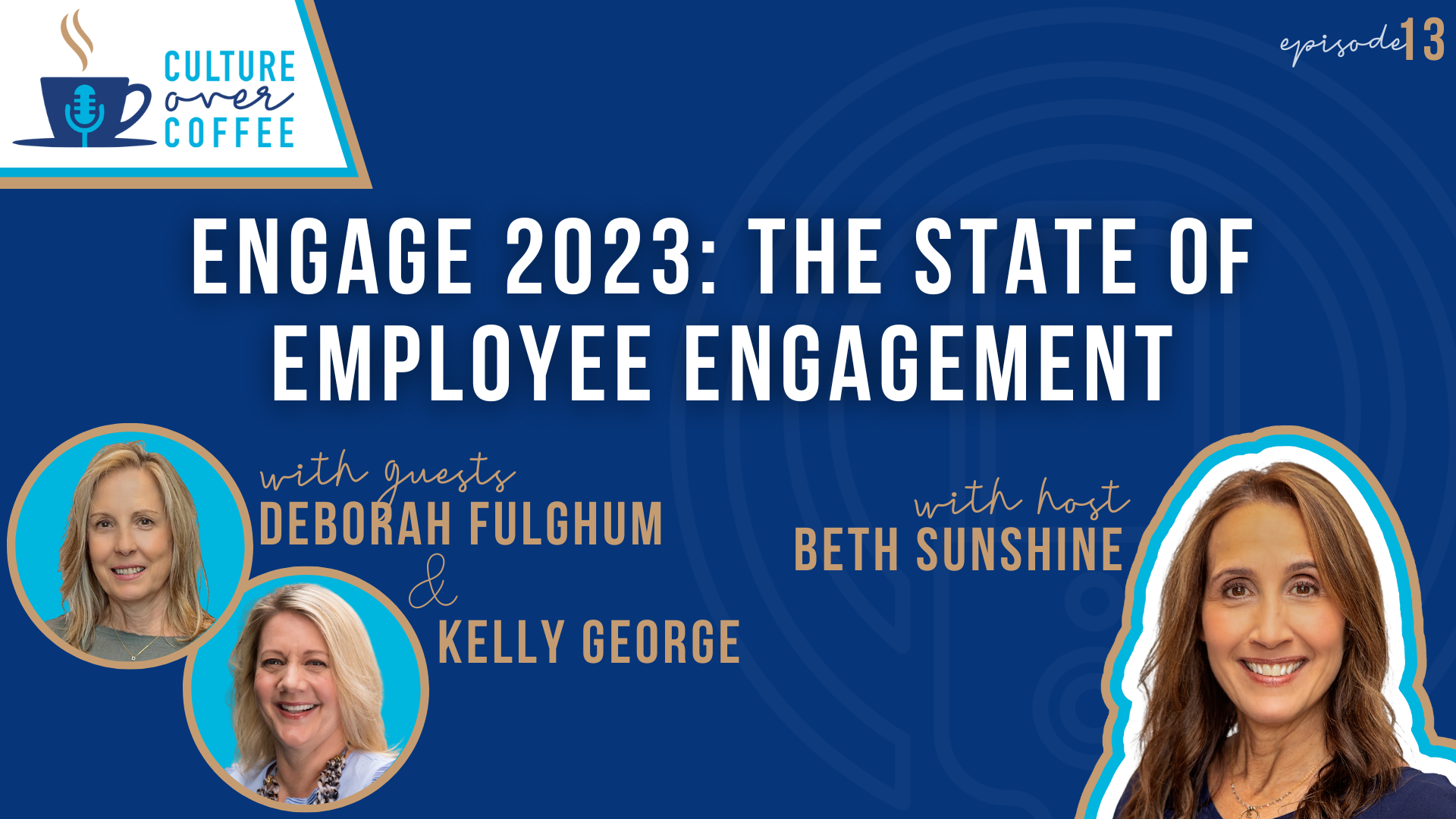
In this episode, we’re beginning our season-long exploration of ENGAGE 2023: The Company Culture Report.
Together, with experts from Up Your Culture and The Center for Sales Strategy, we’ll break down the data and contextualize it with actionable strategies to help keep your company campfire roaring throughout the year.
Joining Beth to dive into the Employee Engagement section of the report are a couple of Up Your Culture’s awesome Engagement Specialists, Deborah Fulghum and Kelly George.
Together, they provide so many essential insights, like:
- How communicating where your company is headed directly affects the emotional connectedness and commitment of your people
- Why “disengagement contagion” is very real
- And, finally, why it's important to set expectations around how to best contribute to a healthy company campfire
Feeding the Flames of Your Company Campfire
“I am really excited to get your perspectives on our annual culture report,” Beth says, kicking off the conversation. “There's a lot to unwrap here. So, thank you both for joining me in this first episode of this season.
“Today, we're going to focus on some key findings related to the Employee Engagement section of the report. We're going to talk about what leaders can do to add some fuel to the fire. And you know, I'm using the term fire for a reason.
“So just to set the stage for our listeners, the three of us, the rest of our team, and our clients often liken the three levels of employee engagement to what you would see around your company campfire.”
What is the Company Campfire?
“Picture all of your employees around a company campfire....”
- Engaged: “Those who are engaged, they're the ones who are actively rubbing sticks together. They're creating sparks; they're stoking the fire.”
- Not Engaged: “Those who are not engaged, they're lounging around, they've got their feet kicked up, they're letting other people do the work.”
- Actively Disengaged: “Then the actively disengaged. They're the ones who are dumping water on the fire, removing logs.”
“With that campfire image in mind, I think this will be fun to talk about.
“This survey gave us a great picture of what company campfires are looking like right now as a whole, and I'll start with you, Deb. I'd love to know from you, just in general terms, what were your takeaways from the Employee Engagement section?”
“There are so many good things,” Deborah says. “The importance of knowing where we're headed, being there together to stoke the fire. You know, it's not just a one-person job. It takes everybody to keep that fire going.
“So that's that shared mission that gets everybody charged towards the same thing.
“And I see that so many people really are motivated by having a vision and knowing where they're headed. So that was a good takeaway for me in this section.”
“Yeah, I agree,” Beth says. “Kelly, coming to you, did anything else stand out to you related to just the company campfire and engagement overall?”
Kelly says, “I was so, so excited to see that 77% of those who responded are ‘All In.’
“I just love seeing that they're, similar to what you were saying, Deb, feeling emotionally connected and committed to their companies. They're feeling committed to the work they're doing, and that is definitely keeping those campfires burning bright every single day.
“And the other thing that I thought about is that we also know even a few disengaged people can have such an overwhelmingly negative effect on any organization and can dampen that fire. And I know we're going to talk a little bit about that.”
Stopping the Spread of “Disengagement Contagion”
“I'm glad you mentioned that 77% are feeling engaged,” Beth says to Kelly. “Let me share a little bit more on that just so our listeners have the bigger picture there.
“So, you've got 77% of our respondents who said they are stoking the fire. They're keeping it burning bright.
“And nearly a quarter of the respondents (23%) describe themselves as not engaged. So those are the ones feet kicked up. Beverage in hand, they may be happy. This is not to say they're not happy at work, but it is to say they're not actively engaged.
“And then you've got the disengaged; 11% of our respondents admitted that while they are physically present, they can be emotionally absent. And that was a really big number.
“So, Deb, what would you say to organizations that feel as though having a few disengaged employees isn't that big of a concern? Because we've heard that before, ‘most people are engaged, you know, you can't get everybody.’ What would you say to that?
“It makes me sad to hear that,” Deborah says. “Because I know how important the engagement of everyone is.
“You know, there’s that old adage that we've all heard: one bad apple spoils the whole barrel. All it takes is one person to dowse that fire while you're not paying attention. I’ve likened it to having an infection. One person can infect somebody else, and it just spreads like a cold or like COVID did.
“It can just spread and before you know it, it's taken over, and you didn't think it was going to be a big deal.
“So, I think it's so important for people to think about that when they make hires. ‘Is this person going to fit with our team? Are they a culture fit?’
“And we have to think about what a culture fit is. Do they live by our values? Are they going to bring more to our team and help with our innovation and help us grow and expand and get the whole team excited to move to the next level? Are they going to be fanning the flame and making it brighter?
“Or are they going to dowse the fire? Because we don't want those people dowsing things, right?
“We want that flame to keep going. So, I think it's important to think about people who may be on your team who are dowsing that fire, and it might be time to share expectations that we are here to get this fire burning bright.
“If you want to be a part of that, come on. If you don't, then let's have a conversation.”
“Great message,” Beth says. “Something else that really caught my attention was how people perceived the engagement levels of others,” Beth says. “When they look around the campfire, what do they see their coworkers doing or feeling? Sadly, most people reported a lot of water being dumped on that company campfire.
“84% say that they believe some or a few employees at their company are actively disengaged.
“And, this totally blew my mind; 10% said that most of their coworkers are actively disengaged, dumping water on the fire, pulling logs out, undoing all the good that they're doing. I found that a little worrisome.
“A significant 32% also have that one on the screen believe that their company has a serious engagement problem.
“So, Kelly, I want to start with you. First of all, how important do you think it is that people look around them and see engagement, feel that their coworkers are engaged in the mission?”
“It is incredibly important,” Kelly says. And I couldn't agree more, Beth. When I saw those numbers, they were really sobering. I was just really a little bit in shock about those.
“And to what Deb was saying earlier, also around that one apple or that infection. You know, sometimes we can refer to this as disengagement contagion. We definitely want to stop any spread around this type of contagion.
“What this data tells us is people are looking around, and they're seeing that many of their coworkers are not actively engaged or disengaged. And as you share, 32% believe their company has a serious engagement problem. 32%!
“Let's face it, no one wants to work hard; no one wants to actively stoke the fire while others are pouring water on it. That alone lowers engagement across the board.
How to Spot an Engagement Problem
“Deb, that's a lot of people who said that they think their company has a serious engagement problem,” Beth says. “So, I want to ask you, as an engagement specialist, what does an engagement problem look like and how do you spot one?”
“It's easier than you think,” Deborah says. “If you notice:
- Increased Absenteeism: “People are sick a lot or out of the office or have an excuse for not getting things done. That's obvious.”
- Performance Seems ‘Off’: “We're not churning the work or getting excited about things. Like you just said a moment ago, that contagious feeling of wanting to be involved in something doesn't show up.”
- Quality of Work: “We find that quality of work can be lower. It's just the bare minimum just to collect that paycheck.”
- Turnover Rates: “If you have a higher than normal turnover rate happening, that's a clear sign that there's something wrong with your culture, that you should open your eyes, pay attention to what's happening.
- Customer Satisfaction Rates: “If customer satisfaction rates are going down, that's a clear sign that your people are not expressing contagious enthusiasm about their job. The enthusiasm is not transferring.”
- Lack of Innovative Ideas: “I also think that when you don't see as many innovative ideas populating. People aren’t getting creative or feeling free to share their thoughts.”
“That makes sense,” Beth says. “I like what you shared because some of the things you talked about are sort of...anecdotal. Like, you can look around you and just see it or feel it.
“But also, many of the things that you talked about, you can actually measure. You can measure turnover, you can measure customer satisfaction, you can measure even quality and productivity.
“So, lots of things to keep your eye on very specifically.”
Tending To a Garden is Similar to Tending To Culture
“When asked about their company culture overall, 76% reported that they felt it was improving,” Beth says. “I like that. Especially because, when we compared it to last year, that's up from 69%.
“So people are feeling some improvements, some momentum. Of course, we want everyone to believe their companies are going in the right direction. I'd like that number to be a hundred percent. But I'm glad to see that it's improving.
“So, I want to ask you both the same question and Deb, I'll start with you. How would you advise company leaders to build on this momentum? There's some traction happening; what can they do to improve their company cultures and really keep this going so it maybe, eventually, becomes a hundred percent?
“I love that we're having an upswing,” Deborah says. “It tells me how important it is to leaders, right? ‘This is a big deal and we need to pay attention to it.’
“Our company has tended to our culture forever. It's that important to us. It defines who we are and how we treat our people, how we work with each other, and how we work with our clients. It's paramount to our success.
“I like to think of culture like a garden. And, you know, I'm a huge gardener.
“Spring is my favorite time of year because the fruits of my labor are seen, right? I spend fall planting bulbs, pruning, cutting back. I know when to cut my hydrangeas back so that they really give me the best blossoms in the summer. I pay attention to all that. I water, I fertilize, and I make sure I'm mulching to keep the moisture in. It's a constant thing. In the spring, I'm still doing that.
“And then in the summer, what am I doing? I'm pulling weeds. I'm making sure the bad things don't spread like those apples.
“If I didn't take one weed out, what happens to the rest of the garden? It gets overtaken by weeds and it's not beautiful anymore.
“For me to keep that beautiful garden, or for people to keep their beautiful culture, it's something you have to work on all the time, but it should bring you joy like my garden does for me.
“I think the imagery of the garden is a really nice mental image you've left us with,” Beth says. “Thank you for that.
Questions That Leaders Need to Ask Themselves
“Kelly, how would you recommend that leaders improve their company cultures? If maybe, you know, they've spotted an engagement problem, or they are one of those who are feeling some momentum, but they're not there yet. What would you recommend?”
“Well, here's some more good news,” Kelly says. “There’s so much that leaders can do.
“One of the things I believe is that leaders need to look start with themselves. Are they engaged? Because engaged leaders are the ones who inspire and motivate employees to perform at their best.
“These are some questions you can ask yourself:
- “Can you answer ‘yes’ to knowing your ‘why’ and sense of purpose in your work?”
- “Do you live by your company's core values?”
- “Are you holding your team accountable to your company’s core values?”
- “Are you personally motivated as a leader mm-hmm. By the long-term vision of your organization?”
“I think that's a great place to start.
“And then another way that you can learn a lot more about how your employees perceive your culture is by using an engagement survey.
“That helps uncover the factors that are driving engagement or dragging it down.
“And the good news is you don't have to fix everything at once. You can start by choosing one to two items that have the highest impact on engagement at your company. Create a few strategies and start really quickly...get that garden growing, those seeds planted.
“I think it's also really important that...as a leader, you hold people accountable by refusing to tolerate behaviors that don't align with your values and that could really compromise the integrity of your team.
“One of the things we all say is, ‘is what's hanging on the wall happening in the hall?’ I think that's a great question to touch base on.
But really, it's so much about making sure you're taking time to invest in your people, really showing them how much you value them and the work that they do, having regular growth conversations with them around their goals, their motivations, the areas where they need support.
“Similar to what Deb was saying earlier about what's different for a hydrangea versus another type of plant. Every person that you manage is wired differently and they're all going to have their own work style and they're all going to thrive in different conditions.”
“Wow,” Beth says. “So many good tips there.”
The Known is Better Than the Unknown
“I want to talk to you about what happens when people don't have the information they want and they need,” Beth says.
“I think it's human nature to want to know what's ahead. Right now we're dealing with a lot of uncertainty. We have economic uncertainty that is looming and increasing concern about inflation. It can have a very negative effect on how people feel.
“And, as a matter of fact, we learned from this report that one out of every four people we feels unsure about what to expect in the next year. I have found that people actually deal better with bad news and disappointment than they do uncertainty.”
“And company leaders don't have that crystal ball that I know they wish they had. In your experience, are there techniques they can use to help their people feel more grounded?
“The known is better than the unknown,” Deborah says. “And I think that, as you and I were talking about earlier, a peek behind the curtain is always good, right?
“People will start guessing or wondering what's happening and start their own rumors if we don't address something.
“So, we talk about having a shared mission. If we are giving a peek behind, we're saying, ‘here's where we're headed, here's the role you're going to play in that.’
“I think that that's a conversation that has to happen frequently. I find that so many leaders...say, ‘well, I already had that conversation.’
“But people need the consistency of hearing it over and over and over again.
“So instead of a loop, you need to have a coil conversation. You need to bring this up over and over again so people feel comfortable, so they don't feel like I just said something and nothing changes every time.
“It's kind of like when a manager says, ‘when I have more information, I'll let you know.’ And then three months later I’m still waiting and they didn't get back to me.
“Another piece that I find is very important in this uncertain time, is let's take that opportunity to develop our people. Let's help them grow so that they feel like we're still investing in them.
“We can invest in people without a cost. We can find trainings that don't cost a lot of money or any money. If we can find any way to develop our people, I think that it makes them want to invest themselves in the role no matter what the future holds.
“They still feel that there's a calm because you're still investing in them.”
“More great imagery too,” Beth says. “I'd never heard the term ‘coil conversation’ instead of a loop. I think I might steal that from you.
“Kelly are there any other ideas you would recommend?”
“One other thing that occurred to me was just the importance of effective feedback,” Kelly says. “We saw in the data this year that only one in four respondents report receiving meaningful feedback on a regular basis. That's disappointing. That's so difficult.
“We need feedback about our performance and our work, and people really need more positive feedback because it helps them recognize their strengths so that they can keep using those more often.
“We always recommend the ideal ratio of positive to negative feedback, five to one. So as far as helping people feel more grounded, receiving positive feedback really helps them with that.
“That, because it helps them feel safe, and it also helps them be more open to receiving and actually hearing constructive feedback.”
If You Had One Recommendation, What Would it Be?
“I'm going to make you think of only one thing that you would recommend that leaders do,” Beth says. “Or I'll even just say, what people can do to better contribute to a roaring campfire.
“If you could recommend one thing, what would that be? Deb?
Deborah says, “I would say set expectations about how we build that campfire and how everybody needs to be contributing to that campfire.
“What's allowed and what's not allowed. And if you want to sit around this campfire, here's what you're expected to do. I think expectations are huge and you make no exceptions to those expectations.”
“I like that,” Beth says. “I like that because your culture is what you will tolerate.
“Kelly, how about you?”
“Make sure you're all in,” Kelly says. “If you're a leader, make sure you're engaged. Make sure you're actively rubbing those sticks together to create the spark and stoke that fire of engagement.
“I think it really begins with the leaders. So, make sure that you're ‘all in’ with your emotional connection and commitment to the company.”


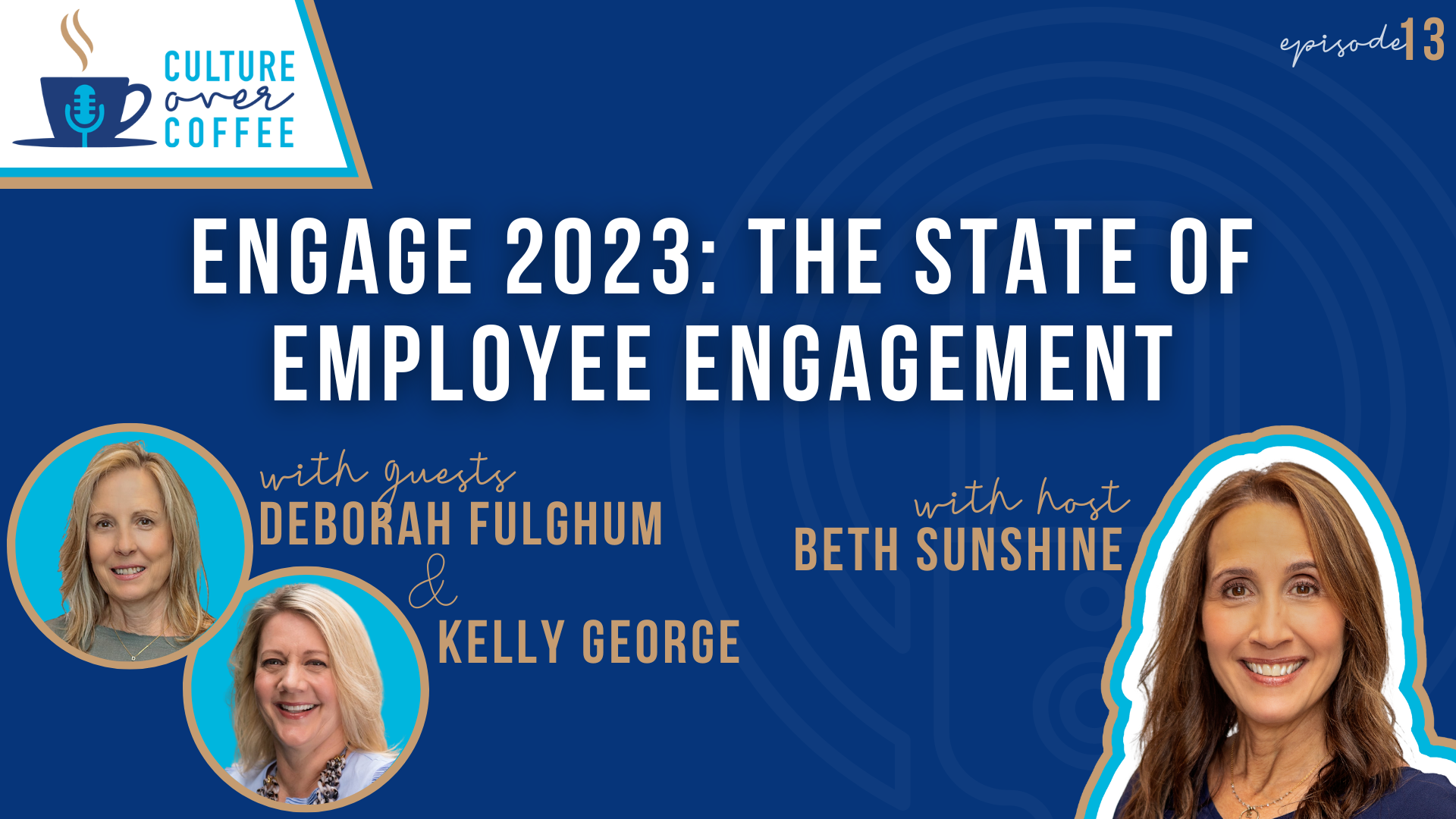





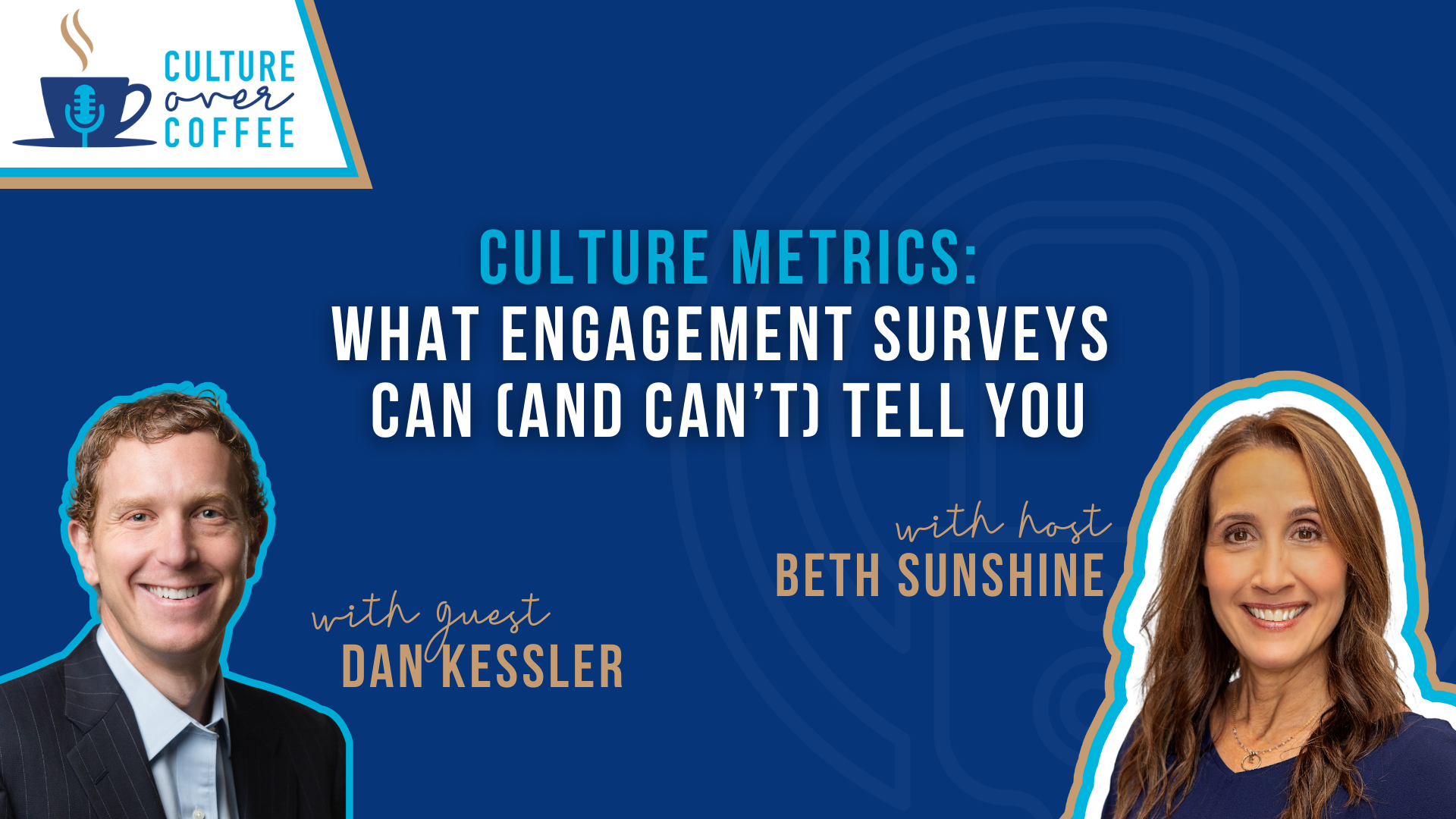
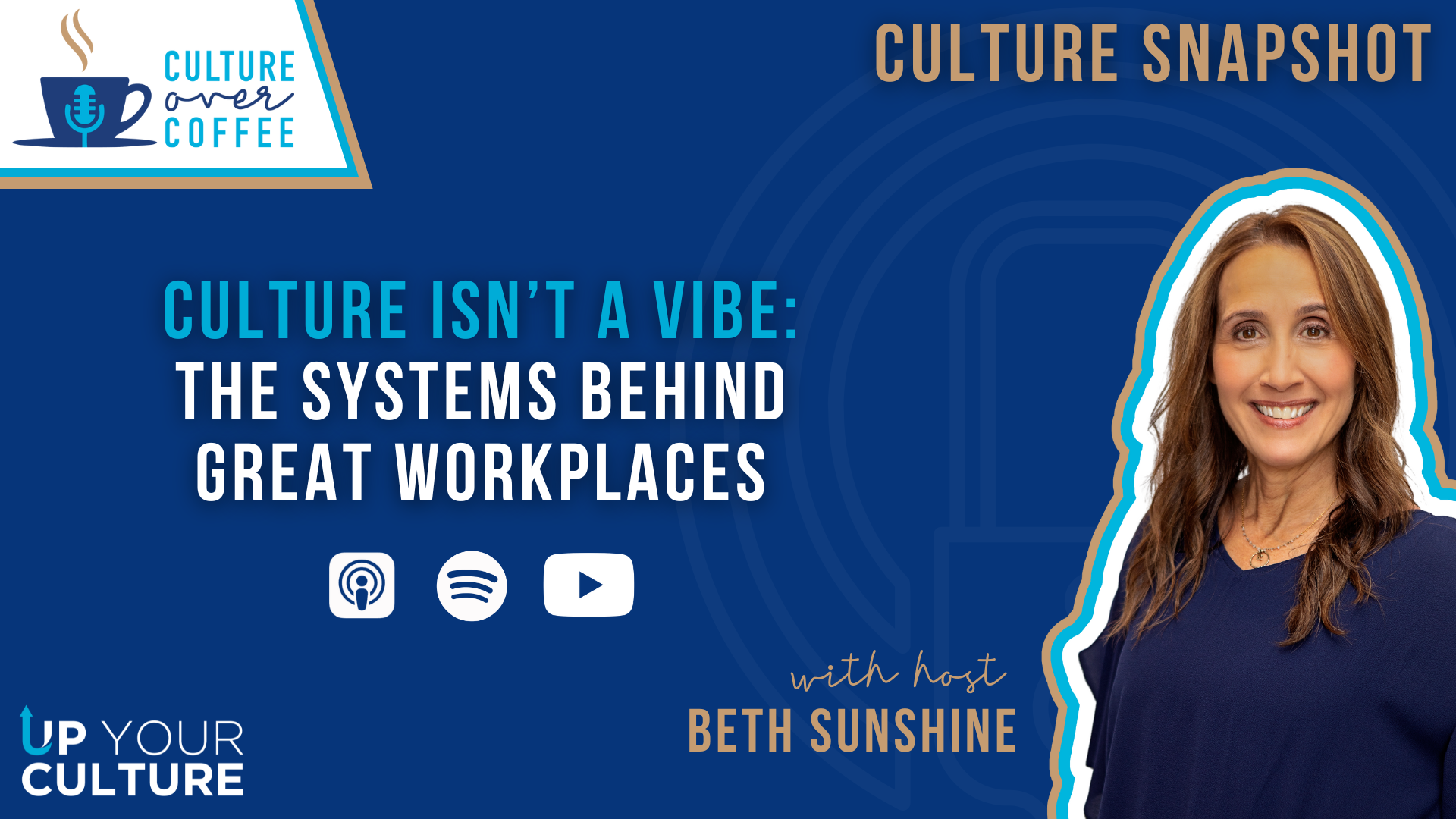
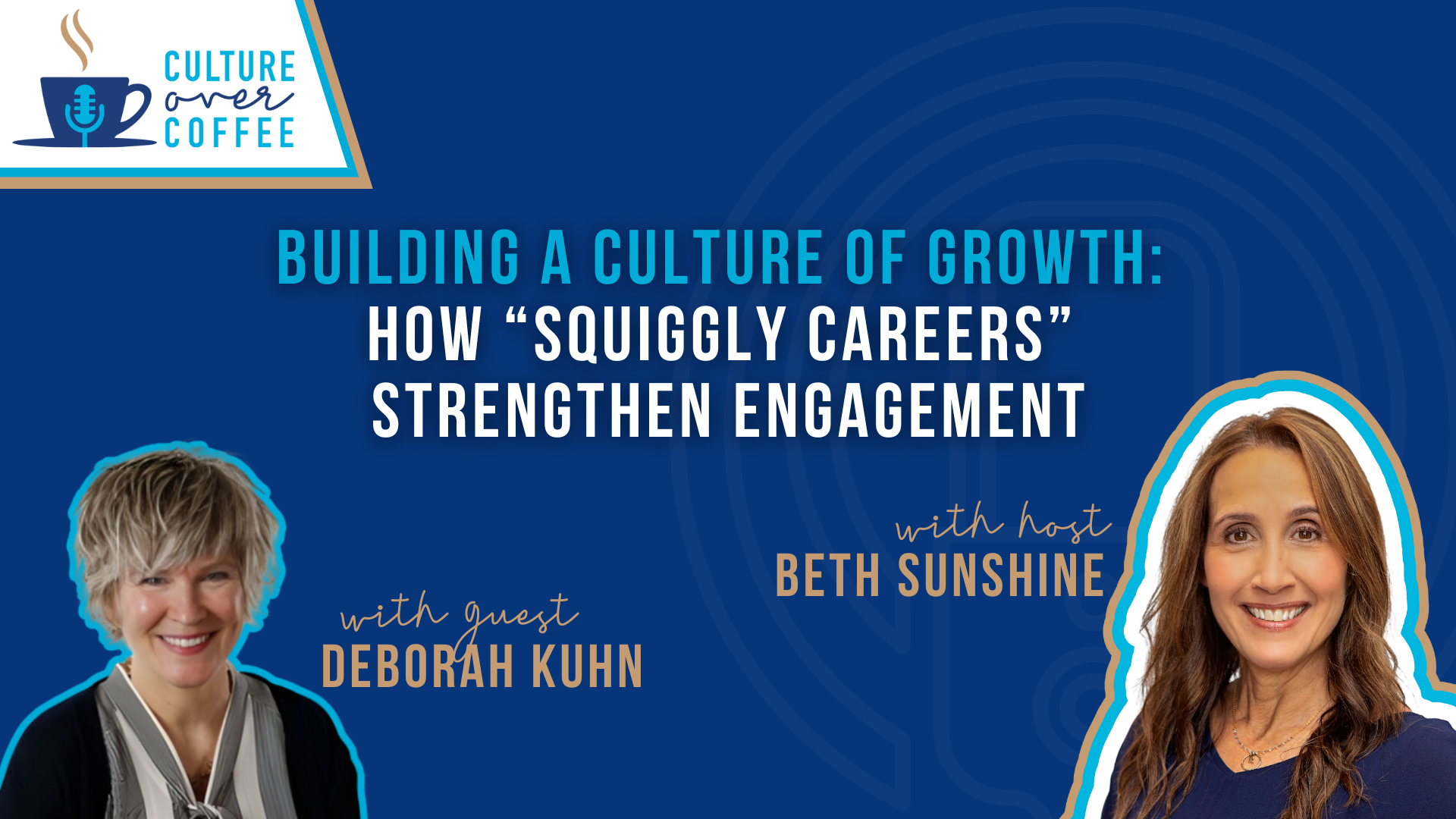

Leave a Comment